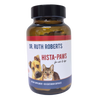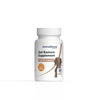Is your pet having trouble with mobility? In this video, Dr. Ruth Roberts explains how gut health in dogs and cats can significantly affect their ability to move and feel comfortable. Dr. Ruth shares expert advice and tips to improve digestion, helping your pet regain their mobility, vitality, and overall well-being. Scroll down to watch!
The Importance of Mobility for Pets
Mobility is crucial for pets, as it directly impacts their overall health and well-being. Regular physical activity benefits mental health, boosts the immune system, improves liver function, and gut health. Inactive pets frequently experience poor digestion, contamination, and other health difficulties.
On the other side, an active lifestyle promotes a healthy microbiome, helps with detoxification, and improves gut function, all of which lead to improved physical and mental wellness. Pets that are kept active preserve muscle mass, improve stability, and avoid diseases like arthritis, all of which are important for dog mobility and cat mobility.
The Impact of Inactivity on Gut Health
Inactivity can have a negative impact on a pet's digestive health. Dr. Ruth Roberts says that when pets are inactive, their gastrointestinal function suffers. Activity is necessary for proper digestion and for food to move efficiently through the digestive system.
Insufficient activity can cause food to linger in the digestive system, leading to fermentation and the production of harmful substances. Dog and cat gut health suffers as a result of this disruption, which damages good tummy bacteria.
Muscle Mass: An Important Factor in Pet Mobility and Immune System
A pet's muscle mass heavily influences their movement. Dr. Ruth Roberts points out that when pets lose muscle, they may become unsteady and less active. This loss in mobility also impacts their immune system and brain function. In order to maintain muscle mass, which supports both dog and cat movement and keeps pets active and healthy, regular exercise and a balanced diet are crucial.
Supporting Kidney Health While Preserving Mobility
When pets are diagnosed with kidney disease, it is critical to carefully monitor their food while also supporting their general health. Dr. Ruth Roberts recommends:
-
Stay calm if creatinine levels are slightly higher (e.g., a level of 2.2 in a 10- to 12-year-old pet often indicates stage 2 kidney disease, not kidney failure).
-
Avoid cutting protein too much as this can result in decreased mobility and muscle loss.
-
Even if your pet has kidney problems, make sure their feed has the right amount of protein. Reducing protein intake is only required if phosphorus levels become problematic
The Role of Prescription Pet Foods in Mobility and Gut Health
Veterinarians regularly prescribe prescription pet diets, but Dr. Ruth Roberts notes that pet food companies supplying these products to veterinary schools often influence these recommendations. Prescription diets can help with certain health concerns, but they may not necessarily promote wellness as well as fresh, whole food diets.
Real, whole food meals have several advantages, such as improved digestive system in dogs, increased cat gut health, and better support for dog mobility and cat mobility. You may support their pets' active lifestyles and ensure their long-term life and enjoyment by selecting natural and nutritious feeding options.
Final Thoughts
To keep your pet in top shape, focus on maintaining their mobility and muscle mass. These factors are critical for digestion and overall health. Inactivity can harm their gut health, slowing digestion and reducing beneficial gut bacteria.
Kidney disease also requires careful attention to protein levels—too little protein can weaken muscles, while the right amount supports strength and health. While prescription foods are often prescribed, whole foods can be a more natural and effective choice, especially for pets with specific health conditions like kidney disease.
Want to learn more about holistic pet care?
👉 Explore our latest blogs for expert tips and insights on everything from mobility to nutrition.
👉 Ready to take it further? Schedule a one-on-one strategy session to create a personalized wellness plan for your furry companion.
Remember, you’re not alone in this journey—every step you take brings your pet closer to living their best life. Keep exploring, keep learning, and most importantly, keep moving!
















